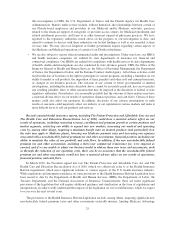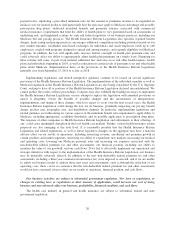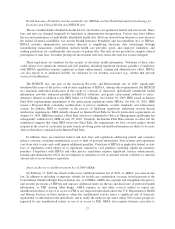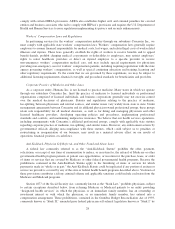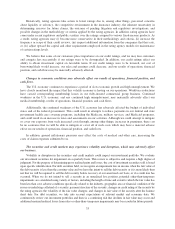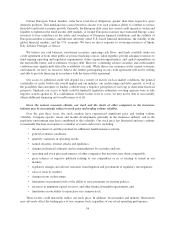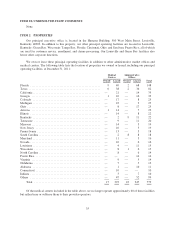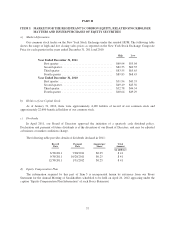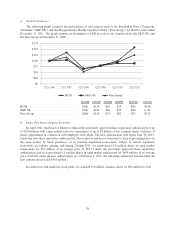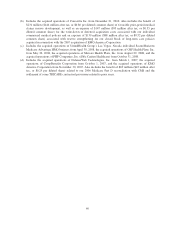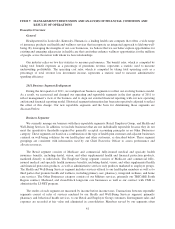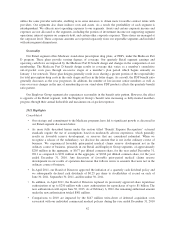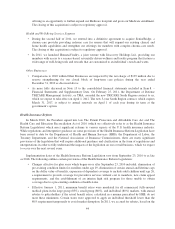Humana 2011 Annual Report Download - page 44
Download and view the complete annual report
Please find page 44 of the 2011 Humana annual report below. You can navigate through the pages in the report by either clicking on the pages listed below, or by using the keyword search tool below to find specific information within the annual report.Certain European Union member states have total fiscal obligations greater than their respective gross
domestic products. This imbalance has caused investor concern over such countries ability to continue to service
their debt and foster economic growth. Currently, the European debt crisis has caused credit spreads to widen and
liquidity to tighten in the fixed income debt markets. A weaker European economy may transcend Europe, cause
investors to lose confidence in the safety and soundness of European financial institutions and the stability of
European member economies, and likewise adversely affect U.S.-based financial institutions, the stability of the
global financial markets, and the U.S. economy. We have no direct exposure to sovereign issuances of Spain,
Italy, Ireland, Portugal, or Greece.
We believe our cash balances, investment securities, operating cash flows, and funds available under our
credit agreement or from other public or private financing sources, taken together, provide adequate resources to
fund ongoing operating and regulatory requirements, future expansion opportunities, and capital expenditures in
the foreseeable future, and to refinance or repay debt. However, continuing adverse securities and credit market
conditions may significantly affect the availability of credit. While there is no assurance in the current economic
environment, we have no reason to believe the lenders participating in our credit agreement will not be willing
and able to provide financing in accordance with the terms of the agreement.
Our access to additional credit will depend on a variety of factors such as market conditions, the general
availability of credit, both to the overall market and our industry, our credit ratings and debt capacity, as well as
the possibility that customers or lenders could develop a negative perception of our long or short-term financial
prospects. Similarly, our access to funds could be limited if regulatory authorities or rating agencies were to take
negative actions against us. If a combination of these factors were to occur, we may not be able to successfully
obtain additional financing on favorable terms or at all.
Given the current economic climate, our stock and the stocks of other companies in the insurance
industry may be increasingly subject to stock price and trading volume volatility.
Over the past three years, the stock markets have experienced significant price and trading volume
volatility. Company-specific issues and market developments generally in the insurance industry and in the
regulatory environment may have contributed to this volatility. Our stock price has fluctuated and may continue
to materially fluctuate in response to a number of events and factors, including:
• the enactment of, and the potential for additional, health insurance reform;
• general economic conditions;
• quarterly variations in operating results;
• natural disasters, terrorist attacks and epidemics;
• changes in financial estimates and recommendations by securities analysts;
• operating and stock price performance of other companies that investors may deem comparable;
• press releases or negative publicity relating to our competitors or us or relating to trends in our
markets;
• regulatory changes and adverse outcomes from litigation and government or regulatory investigations;
• sales of stock by insiders;
• changes in our credit ratings;
• limitations on premium levels or the ability to raise premiums on existing policies;
• increases in minimum capital, reserves, and other financial strength requirements; and
• limitations on our ability to repurchase our common stock.
These factors could materially reduce our stock price. In addition, broad market and industry fluctuations
may adversely affect the trading price of our common stock, regardless of our actual operating performance.
34



